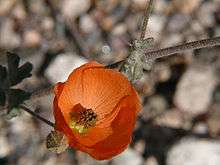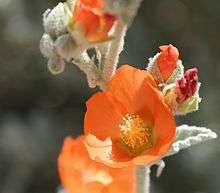Sphaeralcea ambigua
Sphaeralcea ambigua, commonly known as desert globemallow or apricot mallow, is a member of the genus Sphaeralcea in the mallow family (Malvaceae).[1]
| Sphaeralcea ambigua | |
|---|---|
 | |
| Desert globemallow Sphaeralcea ambigua var. ambigua | |
| Scientific classification | |
| Kingdom: | Plantae |
| Clade: | Tracheophytes |
| Clade: | Angiosperms |
| Clade: | Eudicots |
| Clade: | Rosids |
| Order: | Malvales |
| Family: | Malvaceae |
| Genus: | Sphaeralcea |
| Species: | S. ambigua |
| Binomial name | |
| Sphaeralcea ambigua | |
It is a perennial shrub native to parts of California, Nevada, Utah, Arizona, and New Mexico in the United States and Sonora and Baja California in northwest Mexico.[1][2] It grows well in alkaline soil, both sandy or clay, usually in the company of creosote bush scrub and desert chaparral habitats, at 150–2,500 metres (490–8,200 ft) in elevation. It is found in the Mojave Desert, Great Basin desert, and Sonoran Desert ecoregions.[2] It is a larval host to the common checkered skipper, northern white skipper, painted lady, small checkered skipper, and West Coast lady[3].
Description
The Sphaeralcea ambigua plant grows to 3 feet (0.91 m) in height and spreads to 2–3 feet (0.61–0.91 m) in width.[4] The leaves (see image) are fuzzy with white hairs on both sides, lobed, palmately veined, and on long stems, the number of which increase with age. The fruit is a brown capsule containing numerous seeds, first quite spherical as implied by the genus name, later flattening to a disk. The flowers are bowl-shaped, five-petaled, apricot to orange in color, and blooming in the spring.[2]
Varieties
Sphaeralcea ambigua has eight or nine named varieties.[5] They include:
Uses

The plant was used by members of the Shoshoni tribe of Native Americans as a food source and medicinal plant.[10]
Cultivation
Sphaeralcea ambigua is cultivated as an ornamental plant by specialty plant nurseries for use in desert and drought tolerant gardens, and a native plant its desert region's natural landscaping and habitat restoration projects.[4] It requires the following conditions:[4]
- Exposure: full sun
- Water: natural rainfall; supplemental water will increase flowering
- Soil: desert soil, tolerant of some clay, prefers good drainage
- Propagation: easy by seed; tricky by vegetative cuttings; best results from first flush of new spring growth
- Maintenance: low, periodically cut back to keep vegetative look
References
- "Sphaeralcea ambigua". Natural Resources Conservation Service PLANTS Database. USDA.
- Jepson eFlora, The Jepson Herbarium, University of California, Berkeley
- The Xerces Society (2016), Gardening for Butterflies: How You Can Attract and Protect Beautiful, Beneficial Insects, Timber Press.
- University of Arizona Pima County Cooperative Extension - Master Gardeners . accessed 11.11.2011
- Jepson Taxon Report: Taxon Report . accessed 11.11.2011
- Jepson - var. ambigua . accessed 11.11.2011
- Jepson var. aculeata/ambigua . accessed 11.11.2011
- Jepson - var. rosacea . accessed 11.11.2011
- Jepson - var. rugosa . accessed 11.11.2011
- Native American Ethnobotany (University of Michigan - Dearborn) . accessed 11.11.2011
External links
| Wikimedia Commons has media related to Sphaeralcea ambigua. |